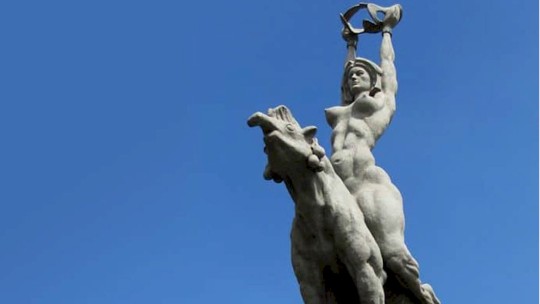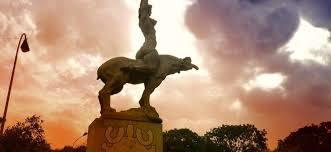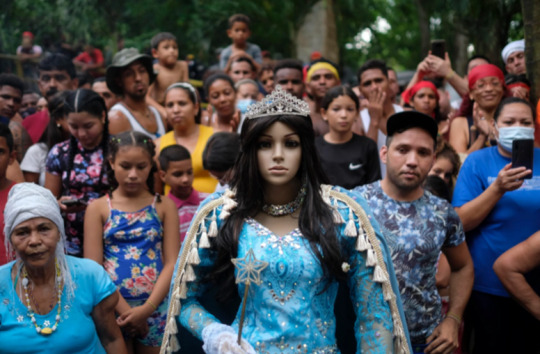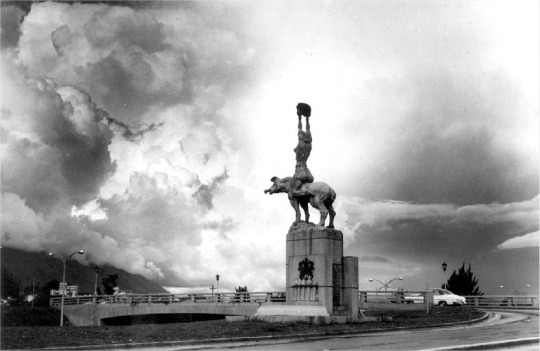#Maria Lionza
Text
Maria Lionza, Lady of the spirits and souls.
The cult of the indigenous goddess Yara de la Onza or Maria Lionza in Venezuela, the same spiritualist cult that has spread to other countries such as Colombia, Peru, and Ecuador, ultimately transcends the comprehension of those occultists and sorcerers who do not reside there.
Maria Lionza is cited in a few books. Most define her as a Venezuelan indigenous legend, a female spirit of native origin, or a "local goddess" of spirits and nature. In Venezuela, Maria Lionza is all of these definitions and more. She is a high magic spiritual entity that assists all those who feel isolated, unappreciated, belittled, marginalized, and mistreated. She and all those who oppose the ideas of the system brought by the colonizers: racism, transphobia, homophobia, religious imposition, patriarchy, etc.
Maria Lionza represents the wild, free, indomitable, and matriarchal aspect of Nature. It is the old story of an indigenous woman who rebelled against the religious institution and freed enslaved people. It is the never-written tale of a powerful woman who discovers in her femininity an intimate connection to divinity and, through it, finds the power to lead the rebellion and claim her role until death and beyond.
Between Animas & Spirits
Maria Lionza acts as a liberator of the Animas and souls from purgatory, just as she was a liberator of the indigenous peoples enslaved by the European colonizers.
She is the central character in the spiritist cult of the animas and spirits in Venezuela. Although the term "Animas" has a massive variety of results according to each Latin American country, in the spiritist aspect, it is the term commonly used to refer to those lost souls, martyred souls, and souls that wander aimlessly in pain, either for having committed suicide or murder, for having seriously harmed others, or (following Catholic tradition) for not having received baptism, although today the latter can be referred to more broadly in the aspect of being an anima that did not follow an established religious current or another spiritual path, and simply has no direction of ascension to follow in the afterlife.
Maria Lionza is the leader of her own spiritual court, and contrary to Santa Barbara, another character of great relevance in the spiritualist cults of the region, who appears as a more modern character and is linked to the Catholic people, Maria Lionza represents the indigenous ancestors and pagan warriors of the past, native sorceresses and their pre-colonization magic, nature's herbal and medicinal secrets, and a connection to all the wild animals of which she has been proclaimed queen.
The animas and spirits serve as messengers of Maria Lionza, a queen in the world of spirits and fairies, the latter being very different characters in Latin America from their European version, darker in character and with a very different origin.
Being a Marialioncero, a priest of Maria Lionza, also implies being a sorcerer who agrees with all these spirits that are present, working at their service and charging them through favors. Conquering the world of spirits is a particular task that requires years of training and constant practice. These are esoteric mysteries not found in books and encyclopedias but hidden in plain sight and in constant and changing practice.
The spirits of low light and the animas act as servants of the queen. They come to the sorcerer or the Chaman to agree in exchange for mutual favors, thus being for them a mission to fulfill beyond life, thus allowing them to somehow way to free themselves from the chains and agony of being souls in pain and serve, beyond death, a purpose superior to them, a spiritual entity of greater power, and work shoulder to shoulder with priests, warriors, and sorcerers of the goddess.
Here Below Classes, Books, and More Content about our Goddess
Save Your Spot for my Upcoming Classes:
Maria Lionza, Goddess of Witches CLICK HERE
Herbal Traditional Magic for Protection CLICK HERE
Other Posts Of Mine To Follow The Topic:Maria Lionza: The Queen of Witches & Fairies.Maria Lionza: A Feminist And Indigenous Cult of Latin American Origin.Marialionceros: The Tradition, Cult, and Spiritism of the Goddess Maria Lionza.A Special Post Made by Me for Tess Whitehurst's Blog:
An Introduction to Queen Maria Lionza, Goddess of Witches, and a Ritual in her Honor.
Pre-Order My Book DREAM WITCHERY:
On Llewellyn Page Click Here
On AMZN Click Here
On Barnes & Noble Click Here
On Bookshop Org Click Here
10 notes
·
View notes
Text
Inauguran Plaza María Lionza en Quibayo estado Yaracuy
Inauguran Plaza María Lionza en Quibayo estado Yaracuy #09Oc #enbreve #news
Este domingo se inauguró la plaza María Lionza en Quibayo, estado Yaracuy, acto que estuvo encabezado por el vicepresidente Sectorial de Comunicación, Cultura y Turismo, Freddy Ñáñez, el ministro del Poder Popular para la Cultura, Ernesto Villegas, y el gobernador de la entidad, Julio León Heredia.
Ñáñez, señaló que «El día de hoy es la absoluta representación de Venezuela. Un crisol de colores…

View On WordPress
2 notes
·
View notes
Text




Graficas Molinari
Las Tres Potencias
#venezuela#las tres potencias#negro felipe#reina maria lionza#guaicaipuro#molinari#colombia#grafica#cromolitography#cromolitografía
7 notes
·
View notes
Note
Hey, OP. Saw your post where you said you he'd the opinion that "it is not possible to be Christian and do magic at the same time, but that has never really stopped Christians." What do you think of the role spiritism has for catholics in Latinoamerica? The church recently beatified(?) a Venezuelan doctor (Dr. Jose Gregorio Hernandez) whose first emergence was... I don't know how else to call it other than "spirity". People would pray to him to cure people, it 'worked' at some point, and the Vatican decided to uh recognize it I guess. Now he's part of the League of Soon-To-Be-Saints, but he still gets called upon by, say, Maria Lionzists in Sorte (I don't know the English word for this, but it's believers of Maria Lionza, one of the biggest spiritual religious movements in the caribbean).
My Point is that's not really a new thing for Christianity. The closer you look at Christian history, you see that it's always been this perpetual negotiation with the concept of magic. For the Catholics, it's ultimately up to the church to decide what gets incorporated and what gets condemned.
Hell, look at the early Christians. Some of the oldest Christian rituals are basically just Roman pagan rites reinterpreted via Jewish apocalypticism. I would even argue that Christianity's ability to incorporate wacky magical/charismatic practices is one of its major strengths as a religion.
294 notes
·
View notes
Text

The Cult of Maria Lionza - Kitra Cahana
#art#editorial fashion#fashion#archive fashion#fashion archive#fashion show#y2k fashion#runway#runway fashion#runway models#artwork#exhibition#theatre#music#visual archive
2 notes
·
View notes
Video
youtube
Willie Colon & Ruben Blades - Maria Lionza mas musica
0 notes
Text
Maria Lionza, the image of the spiritualist cult that the Maduro government seized
Maria Lionza, the image of the spiritualist cult that the Maduro government seized
The replica of the sculpture by Maria Lionza, outside the Central University, in Caracas (Venezuela).apiary
At dawn and with the help of cranes, Maria Lionza, a 6.7-meter-tall woman, who goes naked on a tapir with a pelvic bone as an offering, sculpted in 1951 by the Venezuelan Alejandro, was stolen from the Central University of Venezuela. Hill. The work was part of the art inventory of the…
View On WordPress
0 notes
Link
https://www.donlengua.com/2022/10/confimado-estatua-robada-de-maria.html
0 notes
Text

Comisión presidencial UCV: escultura de María Lionza está a «buen resguardo» https://unionradio.net/comision-presidencial-ucv-escultura-de-maria-lionza-esta-a-buen-resguardo/?utm_source=dlvr.it&utm_medium=tumblr
0 notes
Text
Maria Lionza, Lady of the spirits and souls.
The cult of the indigenous goddess Yara de la Onza or Maria Lionza in Venezuela, the same spiritualist cult that has spread to other countries such as Colombia, Peru, and Ecuador, ultimately transcends the comprehension of those occultists and sorcerers who do not reside there.
Maria Lionza is cited in a few books. Most define her as a Venezuelan indigenous legend, a female spirit of native origin, or a "local goddess" of spirits and nature. In Venezuela, Maria Lionza is all of these definitions and more. She is a high magic spiritual entity that assists all those who feel isolated, unappreciated, belittled, marginalized, and mistreated. She and all those who oppose the ideas of the system brought by the colonizers: racism, transphobia, homophobia, religious imposition, patriarchy, etc.
Maria Lionza represents the wild, free, indomitable, and matriarchal aspect of Nature. It is the old story of an indigenous woman who rebelled against the religious institution and freed enslaved people. It is the never-written tale of a powerful woman who discovers in her femininity an intimate connection to divinity and, through it, finds the power to lead the rebellion and claim her role until death and beyond.
Between Animas & Spirits
Maria Lionza acts as a liberator of the Animas and souls from purgatory, just as she was a liberator of the indigenous peoples enslaved by the European colonizers.
She is the central character in the spiritist cult of the animas and spirits in Venezuela. Although the term "Animas" has a massive variety of results according to each Latin American country, in the spiritist aspect, it is the term commonly used to refer to those lost souls, martyred souls, and souls that wander aimlessly in pain, either for having committed suicide or murder, for having seriously harmed others, or (following Catholic tradition) for not having received baptism, although today the latter can be referred to more broadly in the aspect of being an anima that did not follow an established religious current or another spiritual path, and simply has no direction of ascension to follow in the afterlife.
Maria Lionza is the leader of her own spiritual court, and contrary to Santa Barbara, another character of great relevance in the spiritualist cults of the region, who appears as a more modern character and is linked to the Catholic people, Maria Lionza represents the indigenous ancestors and pagan warriors of the past, native sorceresses and their pre-colonization magic, nature's herbal and medicinal secrets, and a connection to all the wild animals of which she has been proclaimed queen.
The animas and spirits serve as messengers of Maria Lionza, a queen in the world of spirits and fairies, the latter being very different characters in Latin America from their European version, darker in character and with a very different origin.
Being a Marialioncero, a priest of Maria Lionza, also implies being a sorcerer who agrees with all these spirits that are present, working at their service and charging them through favors. Conquering the world of spirits is a particular task that requires years of training and constant practice. These are esoteric mysteries not found in books and encyclopedias but hidden in plain sight and in constant and changing practice.
The spirits of low light and the animas act as servants of the queen. They come to the sorcerer or the Chaman to agree in exchange for mutual favors, thus being for them a mission to fulfill beyond life, thus allowing them to somehow way to free themselves from the chains and agony of being souls in pain and serve, beyond death, a purpose superior to them, a spiritual entity of greater power, and work shoulder to shoulder with priests, warriors, and sorcerers of the goddess.
Here Below Classes, Books, and More Content about our Goddess
Save Your Spot for my Upcoming Classes:
Maria Lionza, Goddess of Witches CLICK HERE
Herbal Traditional Magic for Protection CLICK HERE
Other Posts Of Mine To Follow The Topic:Maria Lionza: The Queen of Witches & Fairies.Maria Lionza: A Feminist And Indigenous Cult of Latin American Origin.Marialionceros: The Tradition, Cult, and Spiritism of the Goddess Maria Lionza.A Special Post Made by Me for Tess Whitehurst's Blog:
An Introduction to Queen Maria Lionza, Goddess of Witches, and a Ritual in her Honor.
Pre-Order My Book DREAM WITCHERY:
On Llewellyn Page Click Here
On AMZN Click Here
On Barnes & Noble Click Here
On Bookshop Org Click Here
3 notes
·
View notes
Text
On “Dead” Cultures and Closed Spiritual Practices: Why Colonialism Is Still A Problem.

Let me start this by saying that, as far as my knowledge of Paganism and Polytheism as a whole goes, I’m what the internet witch community calls a “Baby Witch”. I’m stating this out of the gate because I know there will be lots of people, including witches who have more experience on the craft than me, who might decide to ignore what I have to say based on that fact alone, stating that I’m not knowledgeable enough to give my opinion about this.
Here’s the kicker: I’m a ‘baby witch’, yes, but I’m also a twenty-six year old Venezuelan woman. I’m an adult. I’m Latina. I’m a Christian-raised Pagan,but I’m also a Latinoamerican woman over all other things including that. I grew up on this culture, these are my roots. It is because of this background than I’m writing this post today.
Looking through the “Paganism” and “Witchcraft” tags of this website, I’ve seen a few posts throwing indigenous deities and spirits’ names around on lists alongside deties of open cultures. Yes, you can know better by doing your own research and not going by what just a random Tumblr user wrote on one post (as I hope its the case with everyone on this website), but the fact that pagan beginners are still getting fed misinformation is still worrisome to me.
There’s nothing like reading a so-called expert putting Ixchen (Maya), Xolotl (Nahuatl) and Papa Legba (Vodou) on the same damn list as Norse, Hellenic and Kemetic deities and tagging it on the tags aimed at beginners who might not know better to truly ruin your morning. I’m not mentioning user names here: If you know then you know.
To quote @the-illuminated-witch on her very good post about Cultural Appropriation:
“Cultural appropriation is a huge issue in modern witchcraft. When you have witches using white sage to “smudge” their altars, doing meditations to balance their chakras, and calling on Santa Muerte in spells, all without making any effort to understand the cultural roots of those practices, you have a serious problem.
When trying to understand cultural appropriation in witchcraft, it’s important to understand the difference between open and closed magic systems. An open system is one that is open to exchange with outsiders — both sharing ideas/practices and taking in new ones. In terms of religion, spirituality, and witchcraft, a completely open system has no restrictions on who can practice its teachings. A closed system is one that is isolated from outside influences — usually, there is some kind of restriction on who can practice within these systems.”
A counter-argument I’ve seen towards this when someone wants to appropiate indigenous deities and spirits is to use the “dead culture” argument: Extinct cultures are more eligible for use by modern people of all stirpes. It is a dead culture and dead religion. It would be one thing if some part of the culture or religion was still alive, being used by modern descendants, but the culture died out in its entirety and was replaced, right? They were all killed by colonization, they are ancient history now, right?
Example: “If white people are worshipping Egyptian deities now, then why can’t I worship [Insert Aborigen Deity Here]?”
To which I have two things to say:
Ancient Egypt’s culture was open and imperialistic, meaning they wanted their religion to be spread. This is why Kemetism is not Cultural Appropriation, despite what some misinformed people might tell you. Similar arguments can also be made for the Hellenic and the Norse branches of Paganism, both practiced by people who aren’t Greek/Norse.
Who are you to say which cultures are “dead” and which are not?
Religious practices such as Vodou and Santería certainly aren’t dead, not that it keeps some Tumblr users from adding Erzuli as a “goddess” on their Baby Witch post, something that actual Vodou practitioners have warned against.
Indigenous cultures such as the Maya and the Mapuche aren’t dead, despite what the goverment of their countries might tell you. The Mapuche in particular have a rich culture and not one, but two witchcraft branches (The Machi and the Kalku/Calcu). Both are closed pagan practices that the local Catholic Church has continuously failed to assimilate and erase, though sadly not for lack of trying:
“The missionaries who followed the Spanish conquistadors to America incorrectly interpreted the Mapuche beliefs regarding both wekufes and gualichos. They used the word wekufe as a synonym for ideas of the devil, demons, and other evil or diabolical forces. This has caused misunderstanding of the original symbolism and has changed the idea of wekufe right up to the present day, even amongst the Mapuche people.”
For context, the Wefuke are the Calcu’s equivalent of the Familiar, as well as reportedly having more in common with the Fae than with demons anyway.
This and other indigenous religions are Closed because it is wrong for foreigners to just come and take elements from marginalized groups whom are still fighting to survive and that they weren’t born into. To just approppiate those things would be like spitting in their faces, treating them and their culture like a commodity, a shiny thing, a unique thing to be used like paint to spruce up your life or be special.
I know some of you are allergic to the word “Privilege”, but on this situation there really ain’t a better word to explain it. You weren’t born here, you don’t know what it is like, you are only able to see the struggle from an outsider’s point of view.
If a belief or practice is part of a closed system, outsiders should not take part in it. And with how many practices there are out there which are open for people of all races, there is really no excuse for you to do it.
Why Colonization Is Not “Ancient History”

If you have kept reading all this so far, you are probably wondering “Ok, but what does Colonization has to do with any of this?”
The answer? Everything.
With the general context of culture appropriation out of the way, let me tell you about why the whole “dead culture” argument rubs me the wrong way: Here in Venezuela, we have a goddess called Santa Maria de la Onza, or Maria Lionza for short, whom’s idol statue I have been using to illustrate this little rant. If you happen to know any Spanish, you might recognize the name as a derivative of Santa Maria, aka the Virgin Mary, and you are mostly correct: Her true indigenous name is theorized to have been Yara.
And I say “theorized” because it is a subject of hot debate whether she was really ever called that or not: Her original name, the name by which she was adored and worshipped by our ancestors, might have been forever lost to history.
That’s the legacy of colonization for you: Our cultures were stolen from us, and what they couldn’t erase they instead tried to assimilate. Our ancestors were enslaved, their lands and homes stolen, their artwork and literary works destroyed: The Maya and the Aztec Empire were rich in written works of all kinds, ranging from poetry to history records to medicine, and the Spaniards burned 99% of it, on what is probably one of the most tragic examples of book burning in history and one that people rarely ever talk about.
People couldn’t even worship their own gods or pass their knowledge of them to their children. That’s why Maria Lionza has such a Spanish Catholic-sounding name, and that’s why we can’t even be sure if Yara was her name or not: The Conquistadors couldn’t steal our goddess from us, so they stole her name instead. Catholics really have a thing with trying to assimilate indigenous goddesses with the Virgin Mary, as they tried to do the same with the Pachamama.
On witchy terms, I’d define Maria Lionza as both a deity and a land spirit: Most internet pages explaining her mention the Sorte mountain as her holy place, but it is more along the lines that she is the mountain.
You’d think that, with Venezuela and other Latinoamerican countries no longer being colonies, we’d be able to worship our own deities including her, right?
As far as a lot of Catholics seem to think and act, apparently we are not.
The Catholics here like to go out of their way to shame us, to call us “cultists”, to ostracize us, with a general call to “refrain from those pagan beliefs” because they go against the Catholic principles. Yes, the goddess with the Catholic-sounding name, a name she happens to share with a Catholic deity, apparently goes “against Catholic principles”. You really can’t make this shit up. (Linked article is in Spanish)
This is just an act of colonization out of many, of not wanting to stop until the culture they want to destroy is gone. Don’t believe for a second that this is really their God’s will or anything like that, they are just trying to finish what years of enslavement and murder couldn’t. They might not be actively killing us anymore, but they still want us dead.
So no, colonization is not some thing that has long passed and now only exist on history textbooks: It is still happening to this day. It is by treating it as old history that they can keep doing it, and it is by pushing the narrative that our indigenous cultures are “dead cultures” that they try to erase our heritage.
Because we are not dead. We are still here, we are alive, we have survived and we’ll keep on surviving, and our gods and goddesses are not yours to take.
¡Chao! 🐈
#pagan#paganism#religion#culture#latino#latinoamerica#colonization#witch#baby witch#witchcraft#witchblr#Maria Lionza#colonialism#venezuela#brujeria#polytheism#witchcore#mapuche#vodou#nahuatl#history#cultural appropiation
2K notes
·
View notes
Photo

A statue of Maria Lionza stands in front of followers of her cult during their annual gathering at Sorte Mountain in Venezuela’s Yaracuy state, Monday, Oct. 11, 2021.
(AP Photo/Matias Delacroix)
67 notes
·
View notes
Text
For Women’s Day: Maria Lionza
(abbreviated Maria de la onca, Maria of the tapir) is the central figure in a widespread indigenous religion in Venezuela. The cult of María Lionza is syncretic blend of African, indigenous and Catholic beliefs. She is revered as a goddess of nature, love, peace and harmony, and has followers throughout Venezuelan society, from small villages to Caracas, where in 1951 a monument by Venezuelan sculptor Alejandro Colina was erected in her honour. She rides a tapir, and holds a female pelvis, symbol of fertility. I passed the monument on the highway several times; it has a powerful, primordial presence.
The main place of worship is a cave in Sorte mountain, also known as Cerró Maria Lionza Natural Monument. According to the legend, Maria, daughter of a local indigenous chief, merged with the mountain when attacked by an anaconda. I visited the cave, full of offerings - flowers, candles, incense, cigars, food, alcohol. The glow of candles from the cave is visible from the highway. She’s an unofficial symbol of Venezuela.



28 notes
·
View notes